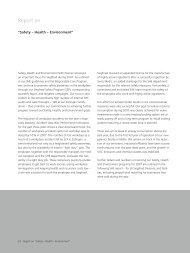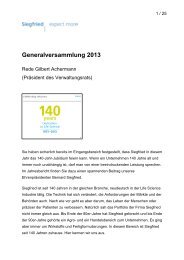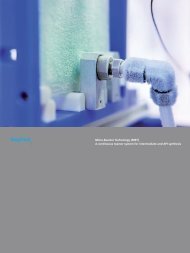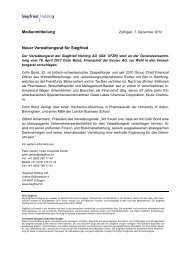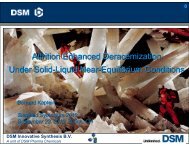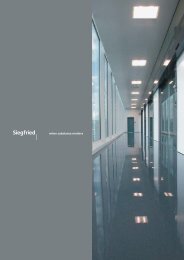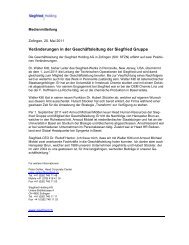You also want an ePaper? Increase the reach of your titles
YUMPU automatically turns print PDFs into web optimized ePapers that Google loves.
Microreactor Technology (MRT)<br />
1. General<br />
A quick search for a definition of Microreactor technology (MRT) produces<br />
at least two versions. One is that from the viewpoint of the manufacturer<br />
of MRT devices:<br />
...components produced by using microtechnology techniques with channels<br />
of diameters of smaller than 1 mm...<br />
Or the viewpoint of the chemist:<br />
A microsystem for chemical and biochemical reactions...as well as analytical<br />
systems. Its small reaction volumes and high heat and mass transfer<br />
rates allow for precise adjustment of process conditions, short response<br />
times, and defined residence times, resulting in greater process control<br />
and higher yields and selectivity. (citation from: www.answers.com).<br />
2. <strong>Siegfried</strong> and MRT<br />
Upon initiation by Max Widmer 2003 <strong>Siegfried</strong> started studying MRT as<br />
a possible expansion of its technological toolbox. There were already several<br />
companies offering reactor units for industrial use or even complete<br />
computerized systems for the optimisation of chemical reactions. The<br />
companies offered to check the feasibility of our reaction candidates as a<br />
service and –to get started at all- we used it for a few of our candidates.<br />
However it quickly became clear that we needed our own MRT setup in<br />
house to develop expertise that would allow us to be able to rapidly check<br />
potential reactions from our customers. Having concrete examples are<br />
mandatory for convincing customers as well as our development and<br />
plant chemists – it is not enough to identify such opportunities just on<br />
paper! In 2005 we opened up the MRT laboratory headed by Dr. Beat<br />
Weber and operated by Norbert Schärer. The goal we set was to have one<br />
reaction candidate on industrial scale within the first year.<br />
It is in short a technology that couples the miniaturisation of chemical reactors<br />
with optimal reaction conditions and eliminating “classical” scaleup<br />
problems. By virtue of the small volume of reactants reacting at any<br />
given time safety concerns disappear, therefore minimizing the need for<br />
process risk analysis and allowing to carry out hazardous transformations<br />
otherwise not suitable for batch processing.<br />
It is therefore easy to list the advantages of MRT<br />
• The miniaturisation of the reactor allows to run demanding<br />
reactions under conditions that are impossible to perform on larger<br />
scale.<br />
• It substantially expands the optimisation “range” of a reaction or<br />
even<br />
• enables a large scale production of reactions not possible in standard<br />
batch reactors. E.g. if an initial conversion yields a reactive or unstable<br />
intermediate a (immediate) subsequent stabilisation step can be<br />
added<br />
• better temperature control results in higher yields and cleaner<br />
conversions (selectivity)<br />
• an optimisation can be done quite fast in an “on-line” mode by<br />
adjusting e.g. feed rate parameters<br />
• an increased output can be reached by numbering up the reactors<br />
• low investment even for industrial scale size for MRT devices<br />
Still, MRT is a technique in development and it takes substantial efforts<br />
and quite some experience until it can be used like any other method in<br />
a companie’s chemical “toolbox”.<br />
Of course only a part of the reactions are suited for MRT studies. Best<br />
candidates are<br />
• fast<br />
• mixing controlled<br />
• exothermic reactions<br />
• with a narrow temperature “window” and<br />
• a high safety risk<br />
<strong>Reaction</strong>s that e.g. have to be performed now at very low temperatures<br />
to ensure the desired temperature in the mixing/reaction zone can be<br />
done at much higher temperature. We have even seen examples where<br />
reactions that need to be carried out at sub zero temperatures in a batch<br />
reactor can be run at ambient temperature, skipping the need for investments<br />
in cryogenic equipment.<br />
Investigation of <strong>Siegfried</strong>’s reaction portfolio as well as some literature<br />
references led to the conclusion that about one out of five conversions<br />
could be candidates for –and should perform advantageously with MRTand<br />
maybe one out of ten would be worthwile to check on lab scale.<br />
Finetuning a micro reactor<br />
3. Build up of a new Technology in House<br />
Of course we started with enthusiasm. However, in this particular case it<br />
was not quite sufficient. The hurdles we encountered were substantially<br />
higher than anticipated and resulted in setbacks. Chemical reactions are<br />
often quite sensitive to changes in reactant ratios. Therefore, feed rates<br />
of the small volume streams have to be controlled within very narrow<br />
margins over long periods of time. The challenge we encountered were:<br />
• Quality control. To ensure continuous good quality conversions a fast<br />
in-line analysis of the reaction is necessary. Deviations from the<br />
optimal quality range have to be detected and corrective measures<br />
initiated immediately<br />
• Engineering. Even if the reactors look like childrens playthings the<br />
ultimate goal is an efficient industrial process running 7 days/24<br />
hours delivering tons. This has to be engineered more carefully than a<br />
large scale setup considering all the “micro problems” involved.<br />
• Technial problems. Clogging pipes, leaking joints, decomposing<br />
sealings, gnawing corrosion, failing pumps, fluctuating flow rates.<br />
• Good reaction candidates. During this set up phase we just did not<br />
have the necessary speed to compete with the (time) needs of our<br />
customers.<br />
One of the big disadvantages of the available commercial reactor units<br />
was the material of construction used. Only a small part of the reaction<br />
candidates can be performed in stainless steel due to corrosion. In our<br />
usual batch chemistry reactors the material of construction is glass or<br />
glass lining to enable the use of corrosive reagents like hydrochloric acid,<br />
acid chlorides, sulfuric acid. All these reaction candidates were therefore<br />
excluded if we were only using steel reactors. These restrictions were too<br />
severe. We needed to expand the reactor material range to what we were<br />
used in batch chemistry. So we were very happy when we were approached<br />
by Corning SAS for a collaboration. Combining Corning’s long<br />
standing experience working with glass with <strong>Siegfried</strong>’s chemical expertise<br />
should yield in substantial progress to overcome many of the hurdles



